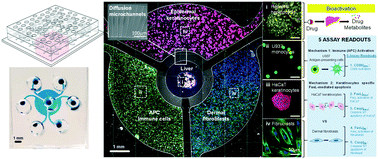Integration of a microfluidic multicellular coculture array with machine learning analysis to predict adverse cutaneous drug reactions†
Abstract
Adverse cutaneous reactions are potentially life-threatening skin side effects caused by drugs administered into the human body. The availability of a human-specific in vitro platform that can prospectively screen drugs and predict this risk is therefore of great importance to drug safety. However, since adverse cutaneous drug reactions are mediated by at least 2 distinct mechanisms, both involving systemic interactions between liver, immune and dermal tissues, existing in vitro skin models have not been able to comprehensively recapitulate these complex, multi-cellular interactions to predict the skin-sensitization potential of drugs. Here, we report a novel in vitro drug screening platform, which comprises a microfluidic multicellular coculture array (MCA) to model different mechanisms-of-action using a collection of simplistic cellular assays. The resultant readouts are then integrated with a machine-learning algorithm to predict the skin sensitizing potential of systemic drugs. The MCA consists of 4 cell culture compartments connected by diffusion microchannels to enable crosstalk between hepatocytes that generate drug metabolites, antigen-presenting cells (APCs) that detect the immunogenicity of the drug metabolites, and keratinocytes and dermal fibroblasts, which collectively determine drug metabolite-induced FasL-mediated apoptosis. A single drug screen using the MCA can simultaneously generate 5 readouts, which are integrated using support vector machine (SVM) and principal component analysis (PCA) to classify and visualize the drugs as skin sensitizers or non-skin sensitizers. The predictive performance of the MCA and SVM classification algorithm is then validated through a pilot screen of 11 drugs labelled by the US Food and Drug Administration (FDA), including 7 skin-sensitizing and 4 non-skin sensitizing drugs, using stratified 4-fold cross-validation (CV) on SVM. The predictive performance of our in vitro model achieves an average of 87.5% accuracy (correct prediction rate), 75% specificity (prediction rate of true negative drugs), and 100% sensitivity (prediction rate of true positive drugs). We then employ the MCA and the SVM training algorithm to prospectively identify the skin-sensitizing likelihood and mechanism-of-action for obeticholic acid (OCA), a farnesoid X receptor (FXR) agonist which has undergone clinical trials for non-alcoholic steatohepatitis (NASH) with well-documented cutaneous side effects.

- This article is part of the themed collection: AI in Microfluidics


 Please wait while we load your content...
Please wait while we load your content...